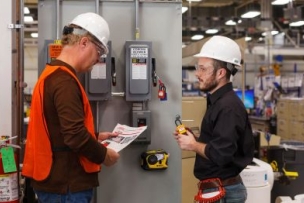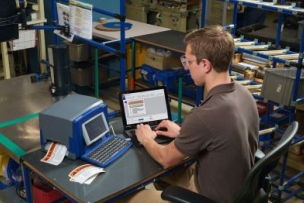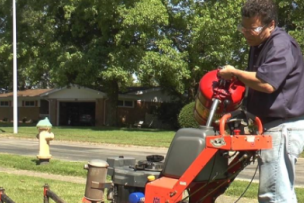It takes a lot to get it right. To be a company that lasts more than 100 years by continually evolving and growing to meet the needs of our markets and customers. Our first-to-the-market and best-in-the-market approach led us to receive hundreds of patents over the years and truly shape an industry. We do what others don't in ways they can't. We offer innovative products backed by years of research and development. Beyond our quality products and reliable solutions, we add value for our customers through strong partnerships and a commitment to solving important problems. Brady offers solutions to help increase safety, security, productivity and performance throughout your facility—everything from printing systems, software and high-performance labels to facility signs, safety devices, expert safety services and more.
OSHA: The “what” behind arc flash compliance
The basic requirement for arc flash compliance is found in OSHA’s General Duty Clause, which states:
“ Each employer shall furnish to each of his employees employment and a place of employment which are free from recognized hazards that are causing or are likely to cause death or serious physical harm to his employees … ”
While OSHA cites and fines employers for failure to protect employees from the dangers of arc flash under regulation 29 CFR 1910.333(a), much of the driving force behind arc flash compliance comes from the National Fire Protection Association (NFPA). The NFPA 70E national consensus standard is a comprehensive standard that contains detailed information on how to protect workers from arc flashes. Employers must consider and adopt NFPA 70E when employees work on electrical systems. While the NFPA 70E standard is not technically a law like OSHA regulations, it is considered the preferred method by OSHA and the National Electrical Code (NEC) for achieving arc flash compliance.
Arc flash assessments
As indicated by OSHA, two arc flash electrical safety requirements are: (1) employee training, and (2) Personal Protective Equipment (PPE). To determine what PPE, training and label information is needed for safety and compliance, OSHA an arc flash assessment to be performed.
The following arc flash standards are most commonly cited by OSHA:
1. 9 CFR 1910.132(d)(1): Requires employers to perform a PPE hazard assessment to determine necessary PPE.
2. 29 CFR 1910.332(b)(1): Practices addressed in this standard. Employees must be trained in and familiar with the safety-related work practices required by 1910.331 through 1910.335 that pertain to their respective job assignments.
3. 29 CFR 1910.333(b)(2)(iv)(B): A qualified person must use test equipment to test the circuit elements and electrical parts of equipment to which employees will be exposed and must verify that the circuit elements and equipment parts are de-energized.
4. 29 CFR 1910.335(a)(1)(i): Employees working in areas where there are potential electrical hazards must be provided with, and must use, electrical protective equipment that is appropriate for the specific parts of the body to be protected and for the work to be performed.
5. 29 CFR 1910.335(a)(1)(iv): Requires employees to wear nonconductive head protection wherever there is a danger of head injury from electric shock or burns due to contact with exposed energized parts.
6. 29 CFR 1910.335(a)(1)(v): Employees must wear protective equipment for the eyes or face wherever there is the danger of injury to the eyes or face from electric arcs or flashes or from flying objects resulting from electrical explosion.
7. 29 CFR 1910.335(a)(2): Employees must use insulated tools or handling equipment if the tools or handling equipment might make contact with such conductors or circuit parts.
8. 29 CFR 1910.269(l)(6)(iii): Requires employers to ensure that each employee working at electric power generation, transmission, and distribution facilities who is exposed to the hazards of flames or electric arcs does not wear clothing that could increase the extent of injury to such a hazard.
9. 29 CFR 1926.28(a): The employer must require that employees wear appropriate PPE during construction work.
NFPA 70E: The “how” behind arc flash compliance
Understanding NFPA requirements
NFPA 70E Chapter 1 is the base standard for compliance with OSHA’s arc flash requirements. Because this chapter is approximately 35 pages long, the following excerpts provide important information relating to assessments, labeling and training:
110.2(A) safety training
The training requirements contained in this section shall apply to employees exposed to an electrical hazard when the risk associated with that hazard is not reduced to a safe level by the applicable electrical installation requirements. Such employees shall be trained to understand the specific hazards associated with electrical energy. They shall be trained in safety-related work practices and procedural requirements, as necessary, to provide protection from the electrical hazards associated with their respective job or task assignments. Employees shall be trained to identify and understand the relationship between electrical hazards and possible injury.
130.5 arc flash risk assessment
An arc flash risk assessment shall be performed and shall: (1) Determine if an arc flash hazard exists. If an arc flash hazard exists, the risk assessment shall determine: a. Appropriate safety-related work practices; b. The arc flash boundary; c. The PPE to be used within the arc flash boundary; (2) Be updated when a major modification or renovation takes place. It shall be reviewed periodically, at intervals not to exceed 5 years, to account for changes in the electrical distribution system that could affect the results of the arc flash risk assessment; (3) Take into consideration the design of the overcurrent protective device and its opening time, including its condition of maintenance.
130.5(H) equipment labeling
Electrical equipment such as switchboards, panelboards, industrial control panels, meter socket enclosures, and motor control centers that are in other than dwelling units and that are likely to require examination, adjustment, servicing, or maintenance while energized shall be field-marked with a label containing all the following information: (1) Nominal system voltage; (2) Arc flash boundary; (3) At least one of the following: a. Available incident energy and the corresponding working distance, or the arc flash PPE category in Table 130.7(C)(15)(A)(b) or Table 130.7(C)(15) (B) for the equipment, but not both; b. Minimum arc rating of clothing; c. Site-specific level of PPE.
Read this whitepaper in its entirety here and learn about additional requirement from the NEC.








Talk to Us!
Leave a reply
Your email address will not be published. Required fields are marked *